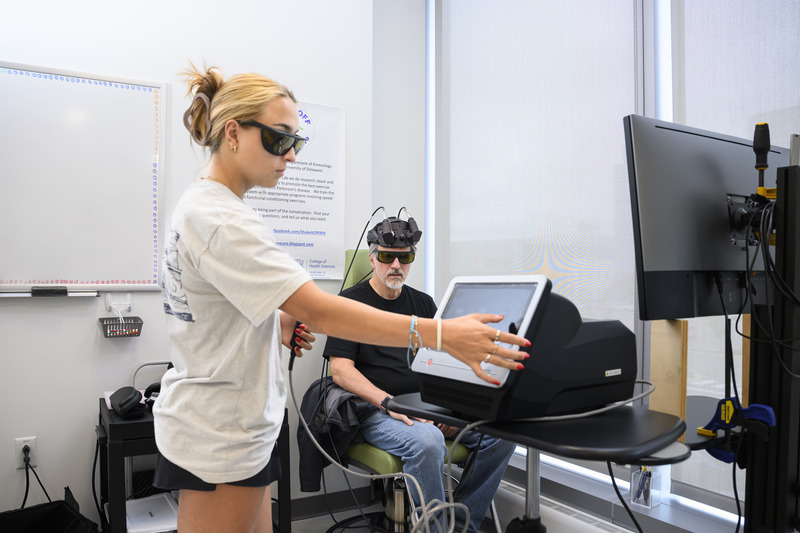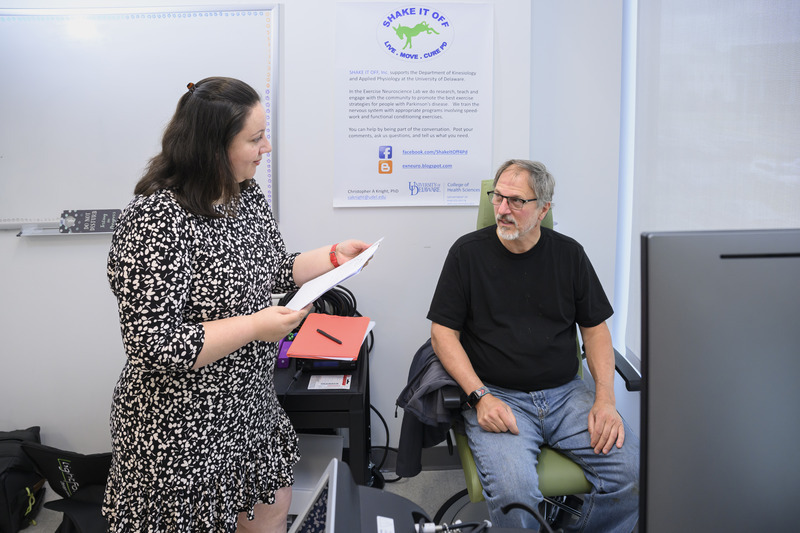


Lighting up hope
Photos by Kathy F. Atkinson July 10, 2025
UD study explores laser therapy to treat Parkinson’s
Tim Hihn, 64, first noticed a significant twitch in his right arm several years ago. He was diagnosed with Parkinson’s disease (PD) in 2021. Since then, the semi-retired sixth-generation mushroom farmer from West Grove, Pennsylvania, has also noticed cognitive changes.
“I used to multitask easily. Now, I have to focus on one task at a time,” Hihn said.
Seeking help, Hihn joined a research study at the University of Delaware College of Health Sciences. Several times a week, he wears a helmet equipped with sensors designed to stimulate the brain with laser therapy.
“It feels like the warmth of the sun on your head,” he said.
The study is blinded, so participants don’t know whether they’re receiving laser therapy or a placebo. Still, after 18 sessions over six weeks, Hihn believes he’s noticed changes.
“Things I used to be good at, like math, memory and organization, I’m better at now,” he said.
The science behind the intervention
Infrared laser technology has been used for decades to treat tendon and muscle injuries.
“Pitchers in the MLB use it before games to increase metabolism in their arm, which seems to have an injury prevention effect,” said John Jeka, professor of kinesiology and applied physiology (KAAP). “Now, we’re exploring how the same technology can benefit the brain.”
In Newark, Brian Pryor, co-founder and CEO of NeuroThera, is studying photobiomodulation as a treatment for major depressive disorder and traumatic brain injury, where it has shown significant promise, as well as for Alzheimer’s and PD.
“Everyone knows somebody affected by these diseases, and they’re desperate for better outcomes,” Pryor said. “Laser therapy has enormous potential.”
Pryor is collaborating with Jeka and co-investigators Thomas Buckley and Roxana Burciu, both KAAP faculty, to study the effects of laser therapy on PD.
The goal is to improve symptoms by targeting brain regions affected by Parkinson’s, such as the frontal cortex, which supports executive function and memory and helps control motor behavior.
“Multiple studies have shown that laser therapy can penetrate brain tissue, improving cellular metabolism and increasing blood flow,” Burciu said. “We hope this leads to improvements in mobility, balance and executive function.”
Their study is unique because it includes a placebo group, which helps determine whether the observed effects are due to the therapy itself rather than expectations or unrelated factors. Participants are also tested off medication, as medication can mask or confound treatment-related changes.
“We want to understand the effects of the treatment on the disease without the influence of medication,” Jeka said.

Some study participants also combine laser therapy with structured exercise.
“Exercise can complement medication in managing symptoms,” Burciu said. “We want to see whether laser therapy, on its own or combined with structured exercise, could lead to greater improvements in motor function than either approach alone.”
To measure outcomes, researchers use wearable tech to track motion and activity. Patients also undergo cognitive testing three months after their final laser therapy session to gauge potential long-term benefits.
The exploratory study is funded by UD’s Big Ideas Challenge and the Delaware Biotechnology Institute.
“This funding is crucial and helps us gather the pilot data we need to pursue larger grants,” Jeka said.
Training the next generation of researchers
Doctoral student Sara Penuela Rodriguez, who’s studying interdisciplinary neuroscience, administers the laser therapy sessions. She came to UD from a small liberal arts college with prior lab experience and is now gaining valuable hands-on training in a Tier 1 research environment.
“STAR Campus offers a world-class research experience for students like Sara,” Jeka said.
Initially interested in psychology, Penuela Rodriguez became fascinated by motor function and shifted her focus to neuroscience.
“PD was not on my radar, but I’ve become so passionate about this work and helping people through research,” she said.
She’s learning not only how to conduct research but also how to engage with sensitive clinical populations.
“Working with people with PD is a privilege,” Burciu said. “It reminds us of the human side of science — the real people behind the data. It offers Ph.D. students like Sara invaluable insight and deepens understanding in ways that textbooks and lectures simply cannot.”
Advancing the science
Investigators plan to test a new helmet that simultaneously stimulates the frontal and motor cortices.
“Hopefully, that has a stronger effect,” Jeka said. “But it will take years to determine.”
Future studies could also utilize MRI and blood biomarkers to track physiological changes associated with PD.
If laser therapy proves to be a valuable intervention that can modify motor and cognitive function and enhance quality of life, researchers want to make it more widely accessible. While Pryor doesn’t expect laser therapy helmets to become at-home devices in the next few years, NeuroThera aims to make them available in medical settings.
“With the dosing we’re delivering, it will likely remain a clinical tool,” Pryor said. “If clinical trials succeed and insurers cover the treatment cost, it could become more accessible.”
Recruitment for UD’s Parkinson’s study is ongoing. To inquire about eligibility, email Sara Penuela Rodriguez at penuelas@udel.edu or check out UD’s Parkinson’s Disease Registry to learn more about all PD research happening at UD.
Contact Us
Have a UDaily story idea?
Contact us at ocm@udel.edu
Members of the press
Contact us at mediarelations@udel.edu or visit the Media Relations website

